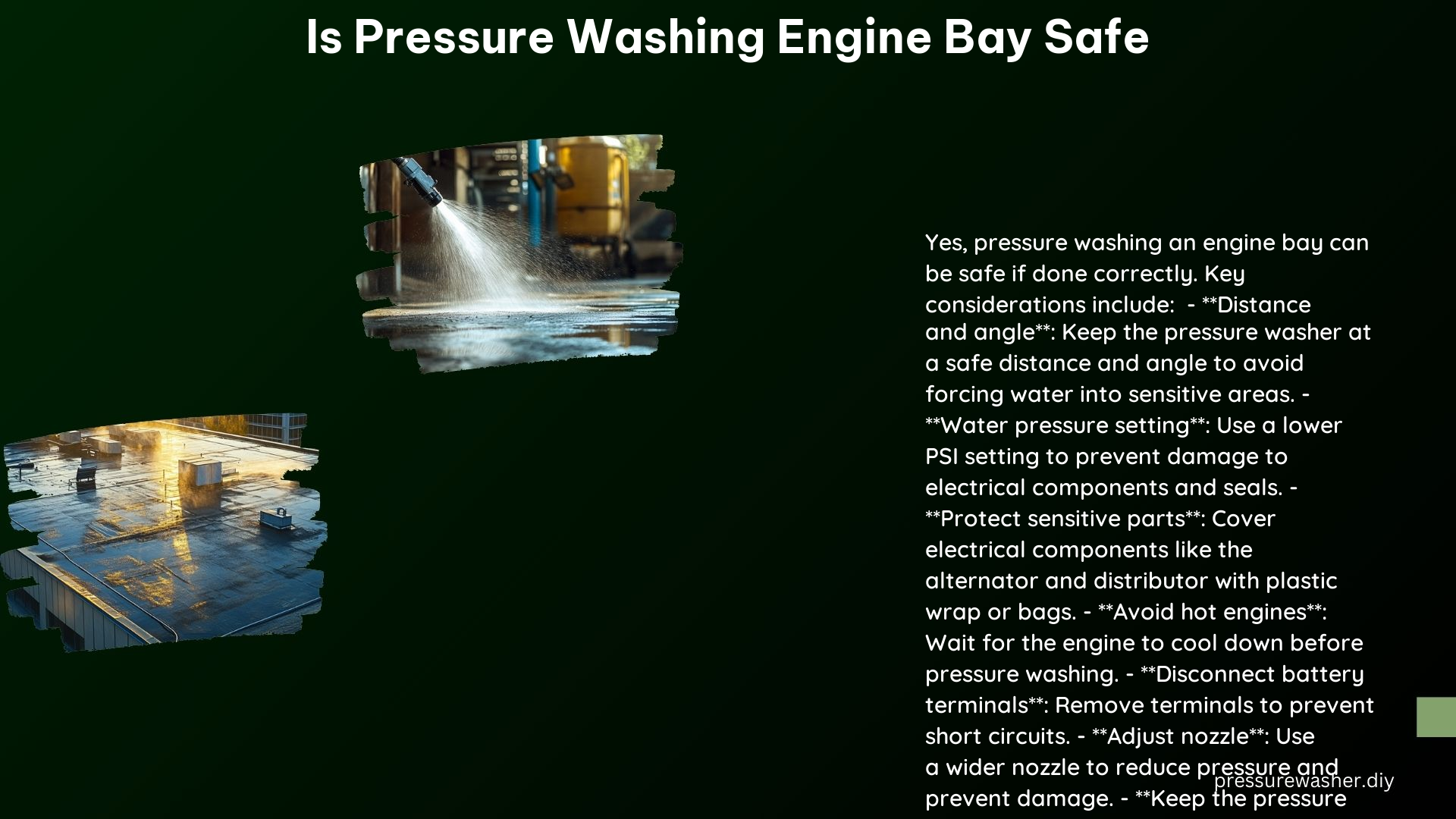Pressure washing an engine bay can be a highly effective way to clean and maintain your vehicle’s engine, but it requires careful consideration to ensure safety and prevent potential damage. This comprehensive guide will delve into the technical details, safety considerations, and best practices to help you pressure wash your engine bay safely and effectively.
Safety Considerations
Avoiding Direct Water Pressure on Electrical Components
When pressure washing an engine bay, it’s crucial to avoid directing high-pressure water streams directly onto electrical components such as the alternator, distributor, and battery. These sensitive parts can be easily damaged by water intrusion, leading to short circuits and other electrical issues. To mitigate this risk, it’s recommended to:
- Cover electrical components with plastic covers or bags to create a barrier against water.
- Disconnect the battery terminals to prevent any potential short circuits.
- Ensure that the pressure washer nozzle is kept at a safe distance (12-18 inches) and angled away from electrical components.
Adjusting Water Pressure and Nozzle
The water pressure and nozzle settings of your pressure washer play a significant role in the safety and effectiveness of engine bay cleaning. Using too high of a pressure setting can force water into inaccessible areas and under seals, potentially causing damage to sensitive components. To optimize the pressure washing process:
- Use a lower PSI setting, typically around 1,000-1,500 PSI, to avoid excessive water pressure.
- Adjust the nozzle to a wider, fan-like spray pattern to distribute the water more evenly and reduce the risk of direct, high-pressure streams.
- Experiment with different nozzle distances and angles to find the optimal balance between cleaning effectiveness and safety.
Avoiding Washing a Hot Engine
Pressure washing a hot engine can lead to thermal shock, which can cause damage to engine components and seals. It’s essential to let the engine cool down before beginning the pressure washing process. Ideally, wait at least 30 minutes after the engine has been turned off to allow it to cool sufficiently.
Using Protective Measures
In older vehicles or those with worn seals, it’s recommended to use additional protective measures to safeguard sensitive engine parts. This can include:
- Covering vulnerable areas with plastic wrap or bags to create a barrier against water intrusion.
- Paying extra attention to areas around seals, gaskets, and other potential entry points for water.
- Inspecting the engine bay for any cracks, holes, or other openings that could allow water to penetrate and cause damage.
Precautions and Best Practices

Using a Garden Hose Instead
For a more controlled and gentle cleaning process, consider using a garden hose with a degreaser and soft brushes instead of a pressure washer. This method can be safer and less likely to force water into sensitive areas, while still effectively removing dirt and grime from the engine bay.
Manual Degreasing
Before using a pressure washer, it’s recommended to apply a degreaser manually and let it sit for a few minutes. This allows the degreaser to break down and loosen the built-up grime, reducing the need for high-pressure water streams and minimizing the risk of water intrusion.
Drying the Engine Bay
After pressure washing or using a garden hose, it’s crucial to thoroughly dry the engine bay to prevent water from seeping into electrical components and causing corrosion or short circuits. Use a high-powered blower or microfiber cloths to ensure that all areas are completely dry before reassembling the engine bay.
Technical Specifications
Pressure Washer Settings
When using a pressure washer for engine bay cleaning, it’s essential to adhere to the following technical specifications:
- PSI (Pounds per Square Inch): Use a lower PSI setting, typically around 1,000-1,500 PSI, to avoid excessive water pressure that could damage engine components.
- GPM (Gallons per Minute): Opt for a pressure washer with a lower GPM, around 1-2 GPM, to reduce the overall water volume and minimize the risk of water intrusion.
- Nozzle Type: Choose a nozzle with a wider, fan-like spray pattern to distribute the water more evenly and reduce the risk of direct, high-pressure streams.
Distance and Angle
When using a pressure washer, it’s crucial to maintain a safe distance and angle to avoid direct water pressure on sensitive engine components. The recommended guidelines are:
- Distance: Keep the pressure washer nozzle at a distance of 12-18 inches from the engine bay surface.
- Angle: Angle the nozzle to avoid directing the water stream directly onto electrical components, seals, and other vulnerable areas.
By following these technical specifications and best practices, you can safely and effectively pressure wash your engine bay without risking damage to your vehicle.
